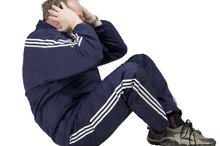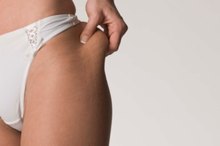How to Tell If Your Legs Are Mostly Muscle or Fat
You've been faithfully working out with leg-specific exercises, including cycling, hiking, squats and deadlifts. Your goal is to become lean, but your thighs and calves seem to be getting larger.
If your legs are typically a problem area, it can be difficult to tell if you're experiencing muscle weight gain or fat. This is especially true in the early stages of fitness, when muscle mass is covered by a layer of fat tissue.
Muscle is leaner, healthier tissue that powers you through workouts and your day. It's firmer and fills out your jeans without jiggle. A few clues let you know if you're carrying more of this desirable tissue on your legs rather than fat.
Gender Differences and Body Composition
Men and women are distinctly different in how they metabolize and store excess fat, according to the University of New Mexico online publication Gender Differences in Fat Metabolism 2.
In individuals with gynoid — or pear-shaped — bodies, excess fat is more likely to be distributed in the legs and hips than around the abdomen. The gynoid body type is more common among females. In contrast, most males who carry excess fat have android — or apple — body types, in which fat is more likely to be stored in and around the abdomen.
If you've always had a heavy lower body, chances are it's just the way you store fat. Even if you slim down, you'll still be shaped like a pear — albeit with less fat all over, including your legs.
Read more: Can You Turn Leg Fat Into Lean Muscle?
- Men and women are distinctly different in how they metabolize and store excess fat, according to the University of New Mexico online publication Gender Differences in Fat Metabolism.
- In contrast, most males who carry excess fat have android — or apple — body types, in which fat is more likely to be stored in and around the abdomen.
Consider Your Body Type
What Body Type Am I if I Gain & Lose Weight Easily?
Learn More
Your body type is a measure of your metabolism and how your body utilizes and stores fat; you're genetically predisposed to certain types. The endomorph body, in contrast to the ectomorph and mesomorph, is efficient in storing fat deposits, giving people with this body type a rounded or soft appearance 1.
Despite this, endomorphs also tend to have very strong lower body muscles. These muscles are some of the largest in your body, meaning that making them physically fit encourages the metabolic rate to increase. Endomorphs also have a tendency to put fat on more easily than muscle, making it more likely that the untrained legs contain disproportionately more fat.
To determine if you're an endomorph, or an ectomorph or mesomorph, consider whether it's relatively easy for you to put on muscle 1. Are you built more like a football lineman (an endomorph) or a marathon runner (ectomorph)? Then work with the body you have by eating a healthy diet and exercising to get as lean as you can for your frame 3. This helps you develop legs that are as muscular as possible.
- Your body type is a measure of your metabolism and how your body utilizes and stores fat; you're genetically predisposed to certain types.
- The endomorph body, in contrast to the ectomorph and mesomorph, is efficient in storing fat deposits, giving people with this body type a rounded or soft appearance 1.
Use Fat Calipers
Fat calipers provide you with an overall measurement that represents your percentage of body fat. You can find a fat caliper at your local sporting goods store or borrow one at your local gym; you'll get a more accurate reading if you have a fitness professional perform the measurement for you.
Although the measurement of body fat is comprehensive for your whole body, the knowledge of your body type or body shape can help you determine where your legs are muscular or have fat deposits over the muscle.
Read more: What Is the Difference Between Weight and Body Composition?
- Fat calipers provide you with an overall measurement that represents your percentage of body fat.
- Although the measurement of body fat is comprehensive for your whole body, the knowledge of your body type or body shape can help you determine where your legs are muscular or have fat deposits over the muscle.
Look in the Mirror
Can Every Body Type Get a Flat Stomach?
Learn More
An easy way to evaluate whether your legs are mostly muscle or fat is to look at them in a mirror. Signs that your legs are muscular include defined lines of separation between the muscles of the hamstrings, quadriceps and calves. Flex the muscles to make these lines even more defined. If your legs aren't toned, this approach may not be as effective, because you won't have the muscular definition.
- An easy way to evaluate whether your legs are mostly muscle or fat is to look at them in a mirror.
- Flex the muscles to make these lines even more defined.
Related Articles
References
Writer Bio
Maura Banar has been a professional writer since 2001 and is a psychotherapist. Her work has appeared in "Imagination, Cognition and Personality" and "Dreaming: The Journal of the International Association for the Study of Dreams." Banar received her Bachelor of Arts in psychology from Buffalo State College and her Master of Arts in mental health counseling from Medaille College.








